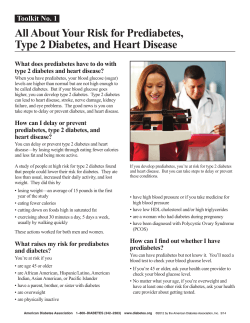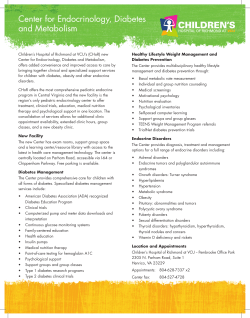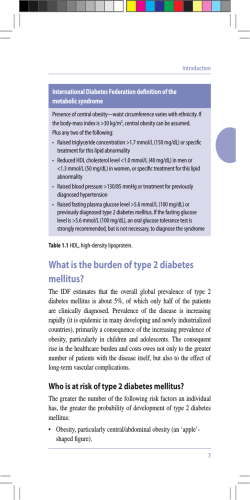
Integration of the Diabetes Population Risk Tool (DPoRT)
Integration of the Diabetes Population Risk Tool (DPoRT) into Public Health Practice Sheila Datta, MSc, Epidemiologist, Peel Public Health Laura Rosella, PhD, Scientist Public Health Ontario Acknowledgements • Peel Public Health: David Mowat, Sheila Datta, Nancy Ramuscak, Julie Stratton • Public Health Ontario: Laura Rosella, Michael Lebenbaum, Ian Johnson, M. Mustafa Hirji, John Wang, Lennon Li, Leslea Peirson • Ottawa Hospital Research Institute: Douglas Manuel • Institute for Clinical Evaluative Sciences : Therese Stukel • Ministry of Health and Long Term Care: Michael Hillmer www.oahpp.ca 2 Objectives • Background: Diabetes Population Risk Tool (DPoRT) • Methodology • Application of the Tool in Peel • Next Steps Analogy: Clinical Risk Prediction Age Diabetes Smoking Blood Pressure Framingham Risk Calculator 10 Year Risk of Coronary Heart Disease Clinical Risk Model Response Lipid profile Covariates 4 Population Risk Modeling Population Characteristics Covariates Math Population Risk Model Population’s Risk of Disease Response 5 Vision Enable a decision-maker to use the characteristics from their population and estimate the number of new diabetes cases in their population of interest for the purpose of: • Resource planning • Prevention • Understand distribution of risk in the population • To facilitate decision making and priority setting www.oahpp.ca Diabetes Population Risk Tool (DPoRT) OBJECTIVE: To create and validate a population based risk prediction tool for incident diabetes mellitus using widely available public data. Validity in this context: 1. With the available factors is this the best model that can be found (statistical) 2. Does the model predict accurately for its intended purpose (public health relevance) www.oahpp.ca Why this approach? • Diabetes surveillance data at the national level is difficult to gather and not linked to many risk factors • Utilizes existing surveillance data on risk factors in Canada • Balancing accessibility with model performance www.oahpp.ca DPoRT creation: • DEVELOPMENT COHORT: Linked1996/7 NPHS in ON (N=23,403) • VALIDATION COHORT 1: Linked 2000/1 CCHS in ON (N=37,463) • VALIDATION COHORT 2: Linked1996/7 NPHS in MB (N=10,118) • Risk attributes: only those that are routinely and publicly available (in the NPHS and CCHS) • Outcome - physician-diagnosed diabetes (ODD & MB version) www.oahpp.ca DPoRT 2.0 – an update! • DEVELOPMENT COHORT: Linked1996/7 NPHS in ON (N=23,403) + Linked 2000/1 CCHS in ON (N=37,463) + Linked 2003/4 CCHS (N = 33,679) • VALIDATION COHORT: Linked 2005 CCHS (N = 33,402) • Risk attributes: only those that are routinely and publicly available (in the NPHS and CCHS) • Outcome - physician-diagnosed diabetes (Ontario Diabetes Database) www.oahpp.ca Validation DPoRT was successfully validated in two external validation cohorts and demonstrated good discrimination and calibration Compare observed and predicted Assess discrimination via ‘ROC-like’ measures (C statistic) www.oahpp.ca Calibrate (re-calibrate) Model Features • Weibull accelerated failure time model • Variables are centered to the mean values of their population (i.e. take into account the baseline level of risk) • Separate for males and females www.oahpp.ca Attributes of DPoRT MALES FEMALES Body Mass Index (Kg/m2) Body Mass Index (Kg/m2) Age Age Non-white Ethnicity Non-white Ethnicity Prevalent hypertension Prevalent hypertension Smoking Immigrant Status Prevalent heart disease Post Secondary Education Post Secondary Education www.oahpp.ca Example use of the Diabetes Population Risk Tool to predict the 9-year risk of diabetes for a specific high-risk man www.oahpp.ca Rosella L C et al. J Epidemiol Community Health doi:10.1136/jech.2009.102244 Applying the risk tool • Sex-specific DPoRT models can be applied to any of the national health surveys in Canada (NPHS or CCHS) for those who are 20 year + and free of diabetes at baseline • The number of new cases is estimated by multiplying the diabetes risk (probability) by the population number www.oahpp.ca DPoRT • DPoRT was designed so that it could be applied to routinely collected and publicly available data allowing the tool to be used by a wide audience • Tool can be applied to quantify impact that changes in baseline risk factors will have on future diabetes incidence • An innovative way to make routinely collected population health data useful for diabetes prevention planning in a practical and meaningful way Rosella L C et al. J Epidemiol Community Health doi:10.1136/jech.2009.102244 16 Application of the Diabetes Population Risk Tool (DPoRT) for Peel Public Health www.oahpp.ca Understanding Diabetes in Peel • The prevalence of diabetes has increased rapidly over the past decade; Diabetes rates in Peel exceed those of Ontario • Without intervention, diabetes is projected to continue rising due to increasing obesity rates and changes to the ethnocultural makeup of Peel’s population • Efforts to understanding diabetes supports the Term of Council Priorities to prevent obesity and diabetes in Peel. • Peel Regional Council understands the need for interventions aimed to reduce the burden of diabetes in Peel www.oahpp.ca Projecting Disease Burden in the Future (2010-2020) Population (age ≥ 20) 2010 New Cases 2011-2020 Incidence Canada 22,298,000 1,967,000 8.8% Ontario 8,511,000 747,000 8.8% 844,000 76,000 9.2% Peel Region www.oahpp.ca 19 Predicted Number of New Diabetes Cases in Peel (2010-2020) Overall 75,032 High Risk 24,672 Obese 24,570 South Asian www.oahpp.ca 15,236 How the Tool Can Be Used to Support Public Health • Forecast future incidence of disease • Characterizing groups at increased risk for diabetes • Casting future needs for medical resources • Estimate the impact of interventions www.oahpp.ca Original Canadian Community Health Survey (CCHS) Overview of DPoRT application in Peel Restrict sample (Peel residents who are age ≥20 without diabetes) Re-code CCHS variables into format required by DPoRT Calculate summary statistics for overall population Use DPoRT risk equation to estimate individual 10-year risk and the number of diabetes cases they represent Identify the effects of prevention activities E.g. Approximately 8,000 cases can be prevented if all of Peel is targeted with intervention with 10% relative risk reduction vs. approximately 8,600 cases prevented if only high risk individuals are targeted with intervention with a 30% risk reduction E.g. Approximately 80,000 new diabetes cases expected in Peel between 2010-2020 Identify high risk Individuals Identify risk across population strata Identify future health care needs E.g. 11% of Peel population as 10year risk ≥ 20% E.g. Peel 10-year risk is 10.5% and 6.3% in lowest and highest income quintiles respectively E.g. Over the next 10 years, approximately 7,600 of these new diabetes cases will develop glaucoma Ten-year Diabetes Incidence Rate (%) by Ontario Public Health Unit (2010-2020) Timiskaming Health Unit HKP R No rthwestern Health Unit Huro n Co unty Health Unit Thunder B ay District Health Unit Durham Regio n Health Department Grey B ruce Health Unit Co unty o f Lambto n Elgin-St. Tho mas P ublic Health Sudbury & District Health Unit Chatham-Kent P ublic Health Renfrew Co unty & District Health Unit Haldimand-No rfo lk P erth District Health Unit P eel P ublic Health Simco e M usko ka District Health Unit A lgo ma P ublic Health Yo rk Regio n P ublic Health Hastings & P rince Edward Windso r-Essex Co unty Health Unit City o f Hamilto n Kingsto n-Fro ntenac City o f To ro nto P eterbo ro ugh No rth B ay P arry So und District Health Unit Niagara Regio n P ublic Health Wellingto n-Dufferin-Guelph P o rcupine Health Unit Leeds, Grenville and Lanark District Health Unit M iddlesex-Lo ndo n Health Unit Eastern Ontario Health Unit B rant Co unty Health Unit Oxfo rd Co unty P ublic Health Regio n o f Waterlo o P ublic Health Ottawa P ublic Health Halto n Regio n Health Department 0 2 4 6 8 10 12 14 Ten-year diabetes incidence rate and number of new diabetes cases in Peel region by BMI category (2010–2020) 35 40000 30 35000 30000 25 25000 20 20000 15 15000 10 10000 5 5000 0 0 <23 www.oahpp.ca Diabetes Cases (N) 23-25 25-30 30-35 35+ Number of diabetes cases 10-year diabetes incidence rate (%) Diabetes Risk (%) Ten-year diabetes incidence rate by age and region in Canada (2010–2020) 20 10-year diabetes incidence rate (%) 18 16 14 12 10 8 6 4 2 0 Under 45 years 45–64 years Canada www.oahpp.ca Ontario 65 year or older Peel Ten-year diabetes incidence rate by sex, age group and region in Canada (2010–2020) 10-year diabetes incidence rate (%) 25 20 15 10 5 0 Under 45 years 45–64 years 65 year or older Under 45 years 45–64 years 65 year or older Male Male Male Female Female Female Canada www.oahpp.ca Ontario Peel Ten-year diabetes incidence rate and number of new diabetes cases in Peel region by Ethnicity (2010–2020) Diabetes Risk (%) Diabetes Cases (N) 40000 35000 10 30000 8 25000 20000 6 15000 4 10000 2 5000 0 0 White www.oahpp.ca South Asian Black Other Number of diabetes cases 10-year diabetes incidence rate (%) 12 Application of DPoRT for Public Health Planning Incident DM Cases in 10 years Number of Cases Averted NNT Weight (Kg) Weight Loss (Kg) 75,032 --- --- 73.3 --- 1% reduction in weight at the population 72,908 2,124 389 72.5 0.7 5% reduction in weight at the population 65,153 9,879 84 69.6 3.7 Individuals with obesity 24,570 --- --- 95.8 --- 5% reduction in the weight of the obese population 20,379 4,191 24 91.0 4.8 10% reduction in the obese population 17,013 7,557 13 86.2 9.6 Current Population Intervention Targeted Intervention www.oahpp.ca Application of DPoRT for Public Health Planning Incident DM Cases in 10 years Number of Cases Averted NNT Current 75,032 --- --- South Asians 15,236 --- --- 12,951 2,285 69 69,394 5,638 --- Targeted Intervention Among South Asians 15% risk reduction among South Asians Multi-pronged Strategy 1% reduction in weight in the population and 15% risk reduction among individuals who are high risk www.oahpp.ca Lifestyle Intervention in 10% highest risk (HR = 0.51) Peel Region www.oahpp.ca QALYs Changed HC Cost Savings Deaths Averted 11,641 $22.0 million 277 30 Making the Case for Funding Public Health Additional QALYs Lost Excess Health Care Costs Excess Deaths Canada 7,430,279 $14,322,496,107.29 180,287 Ontario 2,961,526 $5,706,924,371.02 71,847 307,089 $591,122,791.28 7,444 Peel Region • Assume willingness to spend $50,000 to prevent each QALY • Discount QALYs & Cost Savings by 5% each year • Target a 5% proportional reduction in incidence of diabetes • c/o M. Mustafa Hirji www.oahpp.ca 31 Strengths of DPoRT • Meaningful • Relevant for public health • Simple • Uses data and software available to PHUs • Validated (in 2 external population cohorts) www.oahpp.ca Limitations of DPoRT • Reliance on self-report measures (strength and a weakness) • Use of physician-diagnosed diabetes as an outcome • Does not apply to those < 20 years of age, institutionalized, or on reserve www.oahpp.ca Next Steps for Peel Public Health • Development of user guide • Training Epidemiologists on using DPoRT • Presentation to staff on the applications of DPoRT to support public health practice • Consultation tool • Working with PH teams to help evaluate potential strategies using DPoRT www.oahpp.ca Next Steps: New Knowledge Users • Sandy Bay First Nations Community (SBFN) (Co-I: Sharon Bruce, PhD) • Regional Health Authorities (RHAs) via the Need To Know (NTK) Team (Co-Is: Pat Martens PhD & Randy Fransoo PhD) • Manitoba Health (KU: Patricia A. Caetano PhD: Lead Epidemiologist and Director, Epidemiology & Surveillance Public Health) • Simcoe Muskoka District Health Unit (SMDHU) (KU: Dr. Charles Gardner, MOH) www.oahpp.ca 35 Updates to DPoRT • DPoRT 2.0 • Costing • Obesity Population Risk Tool (OPoRT) www.oahpp.ca 36 Tools to inform the prevention of obesity and diabetes Obesity Population Risk Tool (OPoRT) Baseline BMI Diabetes Population Risk Tool (DPoRT) Future BMI Diabetes (incidence & prevalence) Risk Factors Risk Factors Diabetes Burden Tool (DBT) Diabetes Burden Health Care Utilization Diabetes Complications Costs (total and attributable) Evaluation Objective 3: Evaluate the effectiveness and impact of the KtoA process using a case study approach to provide description, understanding and assessment of the knowledge translation strategies used to put DPoRT into action. Framework for Knowledge Transfer OBJECTIVE 2: Complete the Knowledge-to-Action cycle in different jurisdictions, including: (i) Training and supporting health professionals and decision makers to use DPoRT using their available data on diabetes trends and risk factors; (ii) Assessing barriers and facilitators of DPoRT use; and, (iii) Tailoring and delivering the outputs of DPoRT analyses that will inform decisions about local programming priorities. Ottawa Model of Research Use DPoRT Adapted from Graham ID, Logan J, Harrison MB, et al. Lost in knowledge translation: time for a map? J Contin Educ Health Prof 2006;26:13-24 OBJECTIVE 1: Create and support partnerships among the researchers who developed the tool and the decision makers and other professionals who will apply the tool in local and provincial health contexts in Ontario and Manitoba. This is a foundational objective that will underpin all aspects www.oahpp.ca of the project. 38 Points of consideration • Little evidence on community-level interventions for diabetes • Risk factor focus, rather than diabetes-focus in health units • Epidemiologists and program planners working interactively • Need to evaluate that population risk modeling actually results in better planning • Limitations of DPoRT www.oahpp.ca 39 Contact Information • Laura Rosella ([email protected]) • Michael Lebenbaum ([email protected]) • Sheila Datta ([email protected]) www.oahpp.ca References 1. Rosella, L.C., Manuel, D.G, Burchill, C., Stukel, T.A. A population based risk algorithm for the development of diabetes: Development and validation of the Diabetes Population Risk Tool Risk Tool (DPoRT). Journal of Epidemiology and Community Health. 2011; 65(11): 613-20. 2. Manuel, D.M., Rosella, L.C., Hennessy, D., Sanmartin, C., Wilson, K. Predictive risk algorithms in a population setting: an overview. Journal of Epidemiology and Community Health 2012;66:859-865 3. Rosella, L.C., Corey, P., Stukel, T.A., Mustard, C., Hux, J., Roos, L., Manuel, D.G. The role of ethnicity in predicting diabetes risk at the population level. Ethnicity and Health. 2012;17(4):419-37. 4. Rosella, L.C., Corey, P., Stukel, T.A., Mustard, C., Hux, J., Manuel, D.G. The influence of measurement error on calibration, discrimination, and overall estimation of a risk prediction model. Population Health Metrics. 2012 Nov 1;10(1):20 5. Manuel D.G. and Rosella L.C. Commentary: Assessing population (baseline) risk is a cornerstone of population health planning-looking forward to address new challenges. International Journal of Epidemiology 2010;39:380-2. 6. Manuel DG, Rosella L.C., Tuna M, Bennett C. How many Canadians will be diagnosed with diabetes between 2007 and 2017? Assessing population risk. ICES Investigative Report. Toronto: Institute for Clinical Evaluative Sciences; 2010. www.oahpp.ca 41 EXTRA SLIDES www.oahpp.ca 42 DPoRT K to A Grant Goals and Objectives The OVERALL GOAL of the proposed KtoA project is for researchers and decision-makers in varied health related settings to work collaboratively to build capacity and facilitate the application of DPoRT as a strategic aid for population-based risk assessment, intervention and planning decisions. The specific OBJECTIVES of this project to achieve this goal are to: 1. Create and support partnerships among the researchers who developed the tool and the knowledge users who will apply the tool in local and provincial health contexts in Ontario and Manitoba. This is a foundational objective that will underpin all aspects of the project. 2. Complete the Knowledge-to-Action knowledge application process (KtoA) cycle in different jurisdictions, including: 1. Training and supporting health professionals and decision-makers to use DPoRT using their available data on diabetes trends and risk factors; 2. Assessing barriers and facilitators of DPoRT use; 3. Tailoring and delivering the outputs of DPoRT that will be used to inform programming and policy decisions. 3. Evaluate the effectiveness and impact of the KtoA process using a case study approach to provide description, understanding and assessment of the knowledge translation strategies used to put DPoRT into action. www.oahpp.ca 43 Rosella et al. Ethnicity and Health 2012;17(4):419-37 www.oahpp.ca 10-year population risk (%) 9.85 10.11 10.06 7.83 Rosella et al. Ethnicity and Health 2012;17(4):419-37 7.95 7.97 Incident cases 386,964 396,624 395,215 321,724 326,737 327,671 www.oahpp.ca No ethnicity DPoRT Full ethnicity No ethnicity DPoRT Full ethnicity Model Performance of 3 algorithms C-Statistic No ethnicity DPoRT Full ethnicity H-L χ2 No ethnicity DPoRT Full ethnicity Males Females 0.76 0.77 0.77 0.76 0.76 0.76 11.38 15.36 33.91 6.05 8.00 9.11 Rosella et al. Ethnicity and Health 2012;17(4):419-37 www.oahpp.ca
© Copyright 2026









